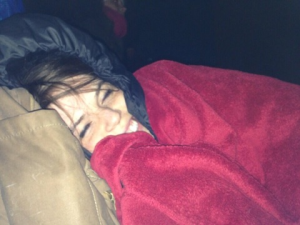Date: April 2nd, 2014
By: Intern

Last Tuesday, the Supreme Court listened to oral arguments in the case of Sebelius v. Hobby Lobby Stores, which will determine if a for-profit company can deny its employees health coverage of contraception based on the religious objections of the company owner. The case represents the latest controversy in the health reform/reproductive justice/religious liberty debate—just how that debate is defined is often an indicator of where one stands.
My story
I grew up in a devout Catholic household in Brooklyn, NY. As a child, I learned early that many of my friends and neighbors did not share my family’s beliefs—the gift and consequence of growing up in one of the most diverse cities in the world. Nevertheless, we recognized that we all enjoyed the same protections to believe and not believe, to practice and not practice a given faith. It is this principle that has most clearly defined my views today, but one that Hobby Lobby appears to question. The store owners and supporters suggest that their religious freedom should trump that of their employees. The court’s definition of this freedom will impact the rights of women across the country to make this choice for themselves.
I decided months ago that I needed to be present for this historic case, but I knew making this a reality would be no easy feat. The Supreme Court contains roughly 400 seats for viewers; of these, many go to friends and colleagues of the justices, groups that have assisted in the counsel of the two legal teams, and the press. The limited numbers of leftover seats are made available to the public. In the days leading up to hearing, forecasts predicted snow, slated to start right in the middle of the night. I enlisted one crazy friend still willing to take a chance to witness history.
As the day finally arrived, we drove from Baltimore to DC, armed with blankets, snacks, and a few vain hours of sleep. Joining the line shortly after 3am we were giddy with the anticipation of the hours ahead. Students of all ages—high school, college, and law school—surrounded us on the street, all attracted to the line by a common spirit. We embodied the hopeful, bushy-tailed energy of the nation’s capital, where policy and society collide in the democratic process. We’ve lived in a time when contraception is legal and not just accepted by our peers, but considered a right. We’re also living in a time where companies have unprecedented power and speech. We knew the collision of these individual and corporate rights may well decide the next period of our lives.
Around 6 am, we were told to pack up and prepare for the first groups to start entering the building. (In reality, the very front of the line would not go in until 7:30am, while others, myself included, waited two more hours to snatch up the last few public seats.) At this point, the protestors started to gather. As we anxiously waited to learn our viewing fate, we watched the physical demonstration of colliding principles. Each side fought to be the loudest, the biggest, and the least able to ignore. Advocates all had their own story of why they came, what they believe, and the result they seek.
After hours of camping, standing, and snow, we were among the final public viewers to make it in the courtroom. The 90 minutes of testimony were among some of the most exhilarating minutes two health policy students/reproductive rights advocates could ask for. There are ample sources across the internet where one might read about the arguments considered, so I will not analyze these here. (A decision is expected in June.) What I do think is worth mentioning is just what that courtroom represented—nine highly esteemed justices, serving life tenures, spent 90 minutes asking questions regarding legal standards and the health and economic costs of these decisions. Hundreds of reporters and legal experts listened for those justices’ tones, signs of opinion, and precedence. Students and other lay public marveled at the judicial process, and the chance to experience history. But outside that courtroom, hundreds of activists withstood snow and opposition to openly declare their principles. They wore shirts and raised signs like scarlet letters, a symbol of solidarity to the views and people they represent.
Beyond that courtroom or the surrounding streets, there are millions of women who stand to feel the impact of this decision. No matter how you define the debate, the answer is monumental for the individual rights to healthcare, religion, and freedom of choice for all Americans. My Hobby Lobby story is just one of the millions that remain to be told.
Emily Gargiulo is a Health Policy graduate student at Johns Hopkins Bloomberg School of Public Health and a Research & Evaluation Assistant at Healthy Teen Network.
Check out a short video of Emily waiting to go inside the Supreme Court.
Notice: Undefined variable: citation in /var/www/html/wp-content/themes/JointsWP-CSS-master/parts/loop-single.php on line 49
Deprecated: get_the_author_ID is deprecated since version 2.8.0! Use get_the_author_meta('ID') instead. in /var/www/html/wp-includes/functions.php on line 4719


